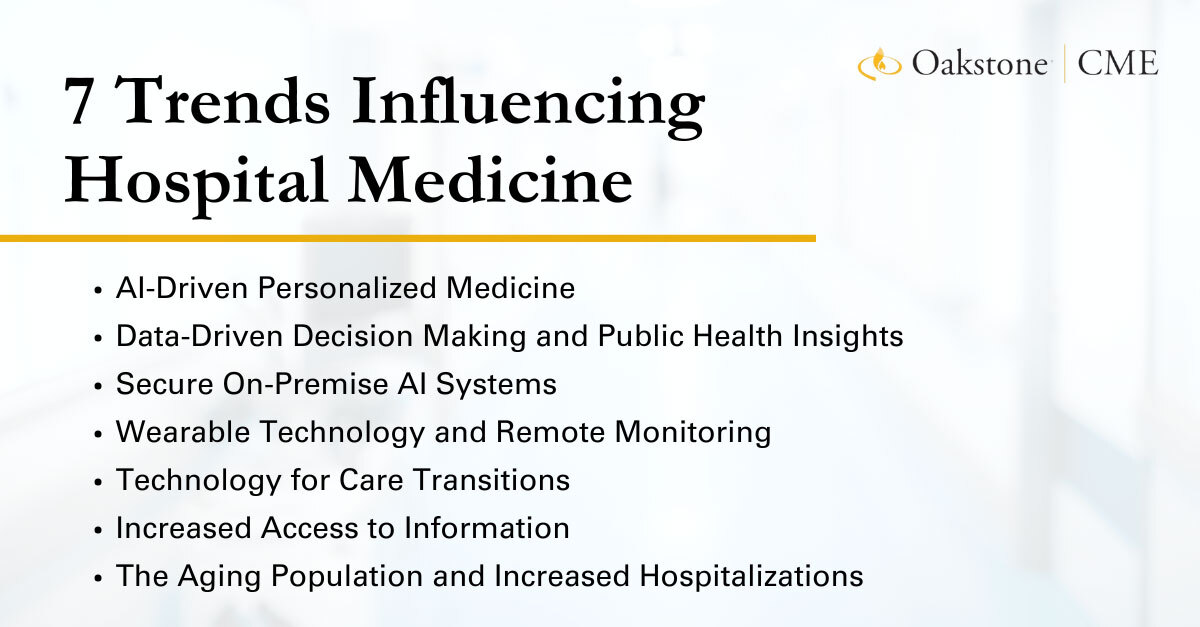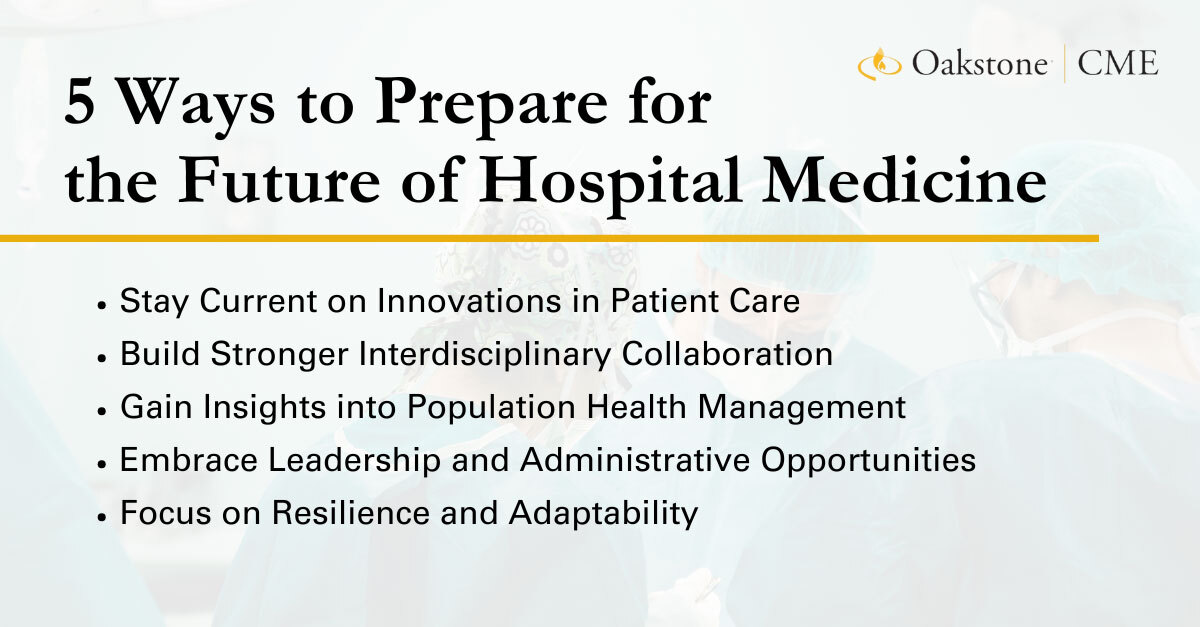The Future of Hospital Medicine

The future of hospital medicine lies at the intersection of technology and human expertise. AI is making diagnoses faster, wearable technology is keeping patients connected beyond hospital walls, and data-driven decision-making is personalizing care like never before. For hospitalists, staying ahead means mastering new tools while never losing sight of the patient at the heart of every breakthrough.
Many hospitalists are already feeling the effects of digital transformation in healthcare, and the number of health systems transitioning to digital tools is increasing. About one-third of healthcare executives have cited technology investments as a business priority in 2025, according to Deloitte.
To navigate these shifts successfully, hospitalists must embrace emerging technologies, adapt their workflows, and develop strategies to stay at the forefront of the rapidly evolving future of hospital medicine. Here are some of the trends influencing hospital medicine, and ways you can stay prepared for change.
7 Trends Influencing Hospital Medicine
The future of hospital medicine will be defined by rapid advancements in technology, shifting patient demographics, and the increasing complexity of care delivery systems. Trends like AI-driven personalized medicine, wearable technology, and secure data systems are transforming how hospitalists work and how health systems operate.
Explore some of the biggest trends influencing your daily hospital medicine practice.
AI-Driven Personalized Medicine
AI in medicine is enabling personalized care. Imagine tailoring treatment plans to each hospital patient based on their unique genomic data or health history. AI tools help you predict patient outcomes, identify the best medications, and create discharge plans that fit each individual. This is especially critical during care transitions when coordination with a primary care physician and outpatient teams is vital.
Learning to use AI effectively can significantly improve patient care and reduce acute care readmissions. By integrating AI into your daily workflows, you can deliver faster, more accurate care while ensuring your recommendations align with each patient’s long-term health goals.
Data-Driven Decision Making and Public Health Insights
The ability of AI to process massive datasets has transformed how hospital medicine physicians approach quality improvement. “One of the things that AI is really superlative at is taking huge amounts of data and identifying patterns,” says Monique Lucarelli, MD, “some patterns that a human might not pick up on.” From predicting hospital patient risks to identifying public health trends, data-driven tools allow hospitalists to make more informed decisions.
Take an example from the University of California San Francisco, where hospitalists are constantly pioneering and testing new applications of AI in patient care. These tools improve care delivery systems by helping interpret and apply immense amounts of data. Developing a deeper understanding of data analysis is key to excelling in the evolving landscape of hospital medicine.
Secure On-Premise AI Systems
With the rise of AI, protecting patient privacy is more important than ever. Secure, on-premise AI systems ensure sensitive data stays within the hospital’s network while empowering hospitalists with advanced diagnostic tools. These AI tools help healthcare institutions comply with strict regulations in the United States while giving you the confidence to use AI for post-acute care planning and decision-making.
To prepare, collaborate with IT teams to learn how on-premise AI can enhance patient care while maintaining compliance. This balance between innovation and security is critical for the future of hospital medicine.
Wearable Technology and Remote Monitoring
Wearable devices are transforming care transitions by enabling real-time monitoring of hospital patients after discharge. These devices track vital signs, detect complications, and alert providers to potential issues — all while empowering patients to take an active role in their recovery.
For example, you might use data from a wearable device to adjust a patient’s treatment plan remotely. These tools not only improve outcomes but also reduce the burden on health systems by preventing unnecessary readmissions.
Technology for Care Transitions
Transitioning from acute care to outpatient status is a critical point in a patient’s journey. Unfortunately, communication gaps between hospitalists and primary care physicians often lead to errors or delays. AI-powered tools can bridge these gaps by generating clear, actionable discharge summaries and monitoring patients at home. “AI can provide very early alerts when it observes changes that may predict a poor outcome or a decline in their status,” Dr. Lucarelli says.
You play a vital role in improving care transitions, ensuring hospital patients receive the right support after discharge. By mastering these tools, you can streamline workflows and enhance patient experiences.
Increased Access to Information
One of the most promising trends shaping the future of hospital medicine is the role of AI in empowering patients with better access to information and support. With tools like AI-driven health concierge systems, patients can get reliable answers to questions they may feel embarrassed to ask or that arise after discharge. For example, if a patient reports swelling or fever post-discharge, an AI system could assess the severity and recommend whether to alert the care team.
“Eventually AI can automatically provide advice lines after a patient leaves the hospital, so that if a patient has questions about their hospitalization that they forgot to ask, they can call and get advice,” Dr. Lucarelli says.
This increased availability of trustworthy, empathetic information empowers patients to take a more active role in their care, reducing unnecessary hospital readmits while improving adherence to care plans. Hospitalists, too, benefit from this shift, as empowered patients often arrive at appointments with more informed questions, enabling deeper, more meaningful discussions.
The Aging Population and Increased Hospitalizations
By 2030, 20% of the U.S. population will be 65 or older, according to the U.S. Census Bureau. As the population ages, hospitals face mounting pressure to manage limited resources. AI and technology can help predict risk factors, allocate resources effectively, and tailor care to the needs of older adults. This is particularly important in managing chronic conditions and avoiding preventable readmissions.
For hospitalists, this trend underscores the need for strategic thinking and collaboration with medical directors and health system leaders. Data plays an important role here, too. “In the future, we'll see those huge amounts of data being very helpful for identifying trends in public health, which, in turn, will help individual patients,” Dr. Lucarelli says. By focusing on innovative solutions, you can meet the needs of an aging population.

5 Ways to Prepare for the Future of Hospital Medicine
Changes in hospital medicine are increasing everyday, putting more and more pressure on hospitalists to keep up. Here are five ways you can stay ahead of change and prepare your practice to embrace innovation.
Stay Current on Innovations in Patient Care
Adapting to technological changes requires more than just learning new tools. It’s essential the tools you acquire are integrated into workflows to enhance both efficiency and effectiveness. Using AI at critical touchpoints can provide better, more accurate care more efficiently.
For example, hospitalists can work with IT teams to ensure wearable device data is actionable, or use AI-driven insights to prioritize at-risk patients. Staying current by leading the transformation of care delivery systems into more proactive, patient-focused models.
Build Stronger Interdisciplinary Collaboration
As care delivery becomes more complex, hospitalists are finding themselves at the center of a growing web of collaboration with primary care physicians, outpatient providers, and IT specialists. Technologies like AI and wearable devices are only as effective as the teams that implement them. For instance, AI-powered tools that generate detailed discharge summaries can only support post-acute care if you work closely with downstream providers to ensure smooth communication.
Building these connections is critical for improving care transitions and ensuring that hospital patients receive consistent support throughout their recovery journey. This might involve participating in cross-functional learning programs or developing shared protocols for interpreting wearable data.
Gain Insights into Population Health Management
Managing aging populations requires not only clinical expertise but also a deep understanding of population health trends. Predictive analytics powered by AI, for example, can help you identify patients at risk for complications or pinpoint gaps in care delivery systems that impact outcomes.
To prepare, focus on understanding how social determinants of health affect your patient population and how technology can support long-term health management. With these tools, you can proactively address both individual and systemic challenges, improving outcomes for patients while alleviating strain on acute care resources.
Embrace Leadership and Administrative Opportunities
As the landscape of hospital medicine evolves, you have the chance to take on leadership roles that shape the future of hospital care. Whether as a medical director or a project lead for integrating AI and wearable technology, you can drive innovation and lead quality improvement initiatives. For example, implementing secure on-premise AI systems ensures compliance with privacy standards while unlocking advanced decision-making tools to support patient care.
Taking on a leadership role doesn’t just mean overseeing operations — it will also include advocating for resources, training teams to adopt new technologies, and collaborating with IT and administrative staff to address challenges. By embracing administrative opportunities, you can influence how technologies are deployed and ensure that innovations benefit both patients and healthcare providers.
Focus on Resilience and Adaptability
The fast-paced changes in hospital medicine can be overwhelming, but hospitalists who prioritize resilience and adaptability will be better equipped to thrive. Staying current with ongoing learning opportunities, like a comprehensive hospital medicine board review, can help you feel more confident in your practice, giving you a solid foundation for innovation.
At the same time, you need to stay flexible and open to learning as new tools are introduced. By embracing the opportunities these innovations bring, you can stay focused on what matters most: delivering high-quality care and improving outcomes for every hospital patient.

Leading the Way in Hospital Medicine
The future of hospital medicine is bright, filled with opportunities for innovation in health care delivery and quality improvement. Technologies like AI and wearable devices are becoming integral to patient care, and you’re uniquely positioned to help lead this transformation.
By staying ahead of these trends, you not only improve outcomes for hospital patients but also ensure your work remains fulfilling and high-impact in the long term. The next step? Embrace the tools and strategies that will shape the future of hospital medicine — and redefine how you care for patients.
Want to learn more about trends in hospital medicine? Explore Oakstone’s Hospital Medicine CME.
